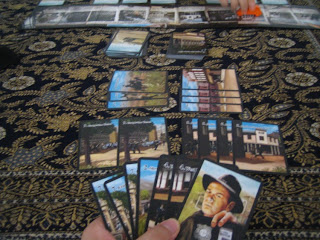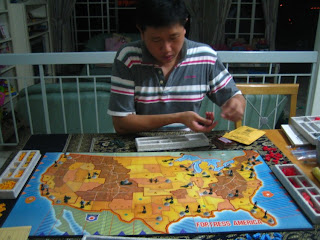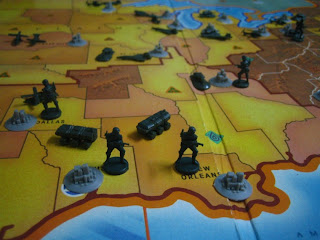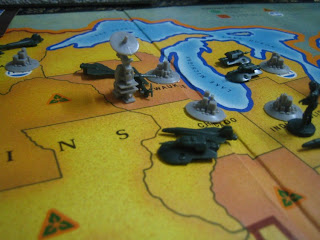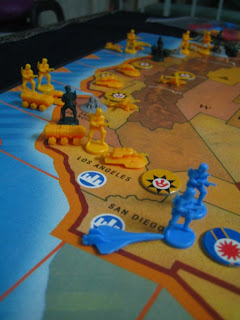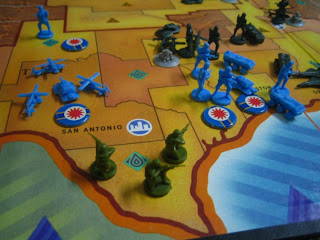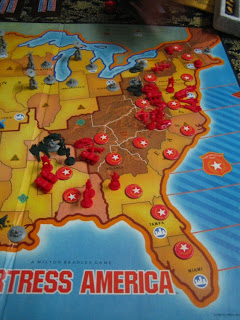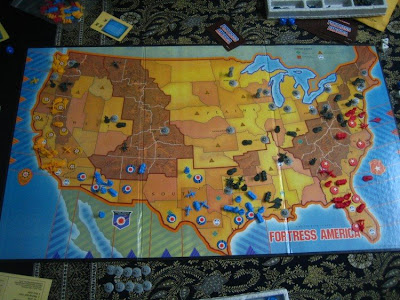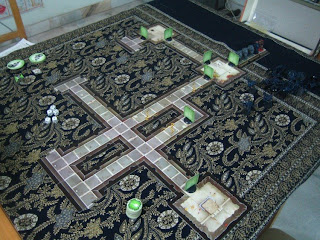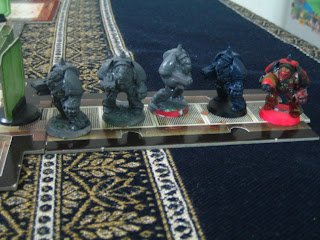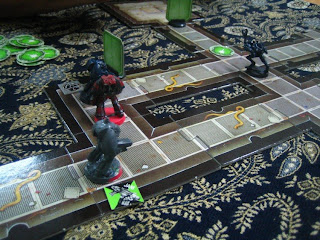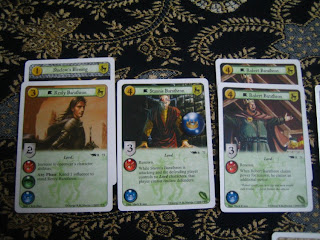I was going to title this blog entry "session 20090328", but then I decided to use something else that I probably would not understand myself a few years from now, which would make me curious enough to check out what this blog entry is about.
On Sat 28 Mar 2009 Chee Seng, Sui Jye and Jing Yi came to play. It has been quite some time since they came to play. Last time was January for Chee Seng, and December for Sui Jye and Jing Yi. We also had a surprise visit from Ricky, who used to play occasionally but is now no longer interested. And we played many games that day. 6 different games, totaling 10 plays. That's rare.
Chee Seng arrived just slightly past 1pm, almost 1 hour early. He had had lunch and had nothing better to do. So we started with Monopoly Express, which he had wanted to try. This is part of a family of dice games including Risk Express (which I also own), Clue Express, and Battleship Express published by Hasbro, which are all quick dice games. I bought Risk Express in Manila, because it was designed by Reiner Knizia, and thought it was an OK game. Not spectacular, but good enough to be played once in a while. I bought Monopoly Express later, but didn't quite like it. Chee Seng was curious to try it, and was considering buying it, so I taught him to play.
He started the game, and did quite well every turn. Earning around $5,000 every turn ($15,000 to win). To catch up, I took some risks, and ended up not earning any money in any turn. The game ended after 3 rounds I think, $16,500 vs $0. Chee Seng told me flatly the game sucks. I'd have to agree. I would have been ready to give him the game if he had wanted it.
One problem I have with Monopoly Express is that it is easy to complete the most expensive set (Park Lane and Boardwalk) by using the chance icon (i.e. a joker). If your opponent gets lucky with that, it's hard to catch up. $3,500 for that set. Also the score keeping is tedious, and is actually more taxing than playing the game itself.
There was still plenty of time before 2pm, so I brought out Lord of the Rings: The Confrontation. I have not played this for a long time. Michelle doesn't like it because she finds it too stressful and too... erm... confrontational. Chee Seng and I have both played this before, but I gave him a quick refresher. He played the bad guys, and me the good guys. Experience put me at a strong advantage. I have played the game very many times, and managed to make good use of many of the common tricks and tactics, e.g. having Legolas pretend to be a lonely Frodo to tempt his Flying Nazgul into attacking (and dying instantly). I also used Merry to instantly defeat the Witch King. Enough of the good guys fought and died and killed the bad guys, to allow Frodo to advance to Mordor without encountering any danger. Not very true to the book or movie, but that's normal.
We had a rematch, this time swapping sides. Again, experience put me at an advantage. Chee Seng's Frodo tried to go through the mines of Moria so that he could bypass the mountains. I had a unit there, and if it were the Balrog, Frodo would die instantly. I warned him, but he decided to take the risk. My unit was the Balrog, and I found out his unit was Frodo. Game over.
I still quite enjoy LOTR The Confrontation. Just somehow I don't like the variant version that comes with the deluxe version (which is not designed by Reiner Knizia). Maybe I am prejudiced. Maybe I have not played enough of the variant game to appreciate it better.
Sui Jye and Jing Yi arrived when Chee Seng and I were playing LOTR The Confrontation. Once we were done, Chee Seng taught us to play Mag Blast, which he brought. I have played this before with Han, but had forgotten the rules. I only remember it is a simple and quick game about spaceships fighting. The game explanation actually took some time, and Jing Yi was intidimated into initially declining to play. I told Chee Seng it was his fault because he insisted that we make stupid sound effects whenever we fired a shot. We managed to persuade Jing Yi to play eventually.
Chee Seng, being the master of intrigue, encouraged everyone to attack everyone else and not himself. That backfired, and he was first to get eliminated. I think him being the game owner (and thus automatically assumed to be the strongest player), and being the common friend (he introduced Sui Jye and Jing Yi to me), spelt his demise. And his obvious sweet-talking definitely contributed too. Sui Jye's mothership was badly damaged very early, but he managed to recruit some ships to take the places of the ships destroyed earlier, and he lasted longer than expected. Jing Yi built up quite a strong fleet, and being the only lady at the table, wasn't attacked too much. Seeing that she had become quite strong, I attacked her, taking out the ship on one side to expose her mothership, and then using a direct hit card to instantly destroy her mothership. My race was the space Amazon-like female race, and my special power was for 3 times during the game I could play a direct hit effect card (usually very devastating) without first playing a direct hit card (normally required). This power sure turned out handy for me.
So it was down to Sui Jye and I. I lost many ships and my front and back were exposed. In a last desperate attempt, I managed to break through his left side, and eventually dealt the last 2 damage to kill his mothership. Victory for me!
The game is a lot of luck. It should be played as a quick silly game. This was the game in which we did a lot of "Jiujiu!" - the laser shooting sound effect. 蕉蕉 in Cantonese. 舅舅 in Mandarin. It actually took us maybe 1.5 hours to play it, including rules explanation. There was text on the cards, which took time to read and understand. I guess once you are familiar with them gameplay will be much quicker. After our game Sui Jye looked at the back of the box, read "game time 10 - 20 minutes" and cursed. How the hell did we manage to spend 1.5 hours on this game?! This should have been a filler game, but turned to be more like a main course.
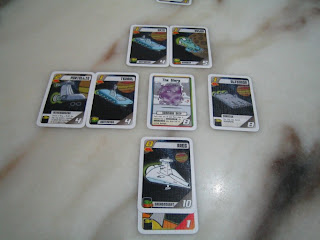
A photo of Mag Blast which I took the previous time I played, at Han's place.
For the main course, I selected Amun-Re, which I have not played for some time. It was the first time for all of them. Chee Seng was earning good money. I focused on pyramid building. I was lucky to draw many master builder cards, which allowed me to build a pyramid with 2 stones instead of 3. In the Old Kingdom scoring Sui Jye led the pack, but I was close behind because of my many pyramids. My cash flow wasn't very good, but I never stole from the temple during prayer time. The gods always blessed me. I wasn't very lucky with the goal cards, not drawing the ones I needed, and drawing those that I could not fulfill.
At game end, I had the same score as Chee Seng, but he won because he had more pyramids. He was quite cash rich during the New Kingdom period (i.e. 2nd half of the game), and managed to buy good provinces which had pyramids carried over from the Old Kingdom Period.
I messed up some rules. When scoring for most pyramids on east and west of the Nile, it should be looking at a single province with the most pyramids, and not the total pyramids owned by a single player. I taught it wrong at the start of the game, and we only learned our mistake when we reached the first scoring stage at mid game. Also when playing the "earn $1 more per farmer" power card, it should only apply to one province, not all provinces. Chee Seng and I played this wrong, but Sui Jye played it right. He referred to the rules himself during the game. So Chee Seng and I had some unfair advantage. Amun-Re is quite a good game. I really should play this more often. But it is probably best with 5 players. 4 players seem to be quite good too, but I don't think 3 players is as interesting.
Halfway through Amun-Re, Ricky dropped by. What a pleasant surprise. I used to play a lot of Axis & Allies with him, using the Iron Blitz computer game version. But nowadays he doesn't play boardgames anymore. He watched us finish the second half of Amun-Re. By then Sui Jye and Jing Yi had to leave. It was about 5pm. We decided to play some quick games, and I chose Loopin' Louie, which neither Chee Seng nor Ricky had played before.
We played about 4 games of this, and it was quite funny. This is a game which is more fun if you are not good at it yet. You can make all sorts of silly mistakes, like hitting your lever too hard and causing your own chicken to fall off the barn roof. When the players get better, the game actually drags, because everyone is getting better at protecting their chicken. Anyway, we had fun. We started shouting "270!", "180!" (in Cantonese), these being the degrees we wanted Louie to turn in order to hit the chicken of the players to our left or right opposite. It is hard to hit the lever just at the right moment and with the right force so that Louie will take that exact flight path to hit your opponent's chicken at an angle that cannot be defended against. Even my 4-year-old daughter Shee Yun, seeing three 30-something grown-ups so absorbed in this silly game, repeated after us, "270!" (广东话∶二百七十).
Since Loopin' Louie was so quick, I decided to introduce Roll Through the Ages to them too. Michelle joined us. This was my first time playing Roll Through the Ages with more than 2 players, and I found that I like it more. There is some additional downtime, but we try to reduce it by having the next player start his turn when the previous player is still completing his turn, unless, of course, the decisions of the previous player can affect those of the next player. But at least the next player can roll the dice first and start planning what to do. With more players, there is more interaction (but this is still a pretty minimal interaction game), there are more monuments to compete for. There is a higher risk of getting hit by pestilence (if someone rolls 3 skulls, everyone else gets 3 disasters, i.e. -3VP), and in this game I was the one who dealt the 3 disasters to the other players.
I thought I wouldn't play Roll Through the Ages much anymore, but now that I have tasted it with more than 2 players, I will likely bring it out again when I have more players and introduce it to more people.



